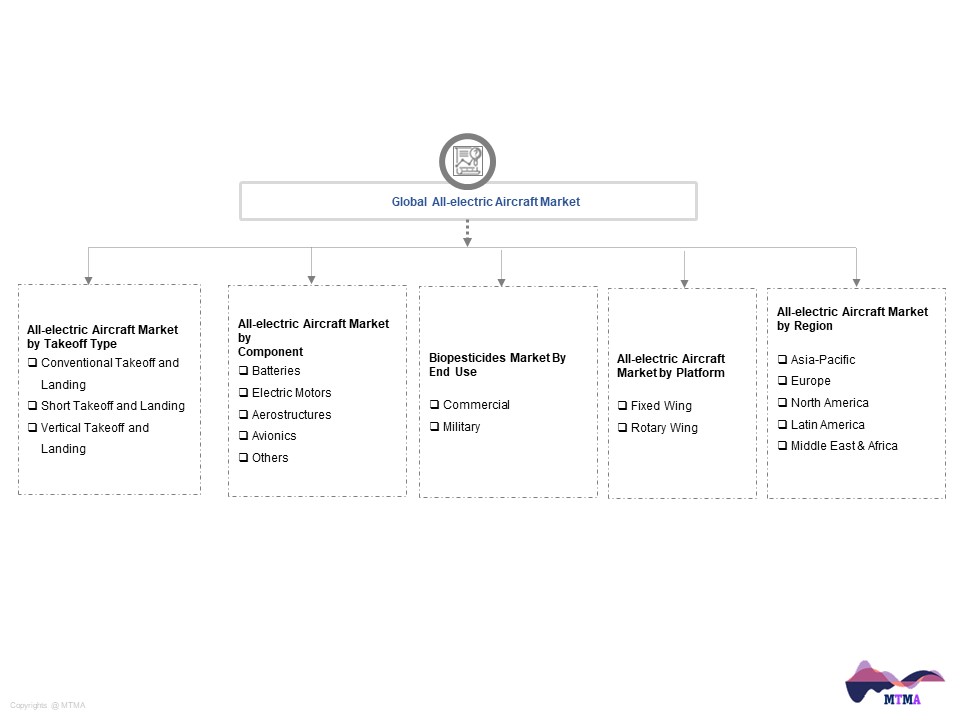- Overvew
- Table of Content
- Segmentation
- Request Sample
Market Definition
An electric aircraft is one that uses one or more electric motors to turn propellers as its means of propulsion. Batteries are the most common method of supplying electricity, however there are other possibilities. Electrically powered variants, which have been flown since the 1970s, are the forerunners of the miniature unmanned aerial vehicles (UAVs) or drones that are currently widely used in the twenty-first century for a variety of reasons.
Market Insights
The market for electric aircraft was estimated to be worth $8.8 billion globally in 2022, and it is anticipated to increase to $22.90 billion by 2030, with a CAGR of 10.75% from 2023 to 2030. Commercial uses of electric aircraft confront a number of difficulties, such as the necessity for big, heavy batteries to produce the necessary power, the requirement to often recharge the aircraft prior to scheduled flight paths, and restricted infrastructure capabilities. The development and use of electric aircraft, however, has increased over the past ten years due to environmental concerns, greater performance offered by cutting-edge electric motor and battery technology, and significantly cheaper maintenance costs associated with electric aircraft. Electric aircraft, which are already marketed by a vast variety of aircraft and helicopter manufacturers, are predicted to make up a sizable portion of the personal aviation market within the next 20 years.
About 3% of the world’s CO2 emissions are caused by commercial aircraft. This percentage is anticipated to climb dramatically since the number of passengers is predicted to continue to rise and because the number of planes is anticipated to nearly double by 2050. By switching to alternative energy sources and using sustainable aviation fuels to power all-electric and hybrid-electric aircraft, industry stakeholders are attempting to cut emissions. Compared to traditional aircraft, all-electric and hybrid electric aircraft emit significantly fewer emissions. Thus, the industry’s sustainability and decarbonization aims will be aided by the growing use of such aircraft. In order to develop and deliver all-electric aircraft for commercial usage, particularly for domestic and regional routes, OEMs are collaborating with battery makers and other stakeholders.
The usage of all-electric aircraft is severely constrained by current battery technology and electric propulsion technologies. The development of all-electric aircraft with adequate range and cargo capacity is being pursued by numerous organisations, governmental organisations, investors, and other parties. All-electric aeroplanes have more benefits than drawbacks. Significant economic and environmental benefits are anticipated from the successful commercial deployment of this aircraft.
The foundation for the creation and usage of commercial all-electric aircraft will be cutting-edge technologies. The industry will advance and contribute to the required results thanks to technology development, particularly in the fields of batteries and motors. By 2025, advanced battery technology with a high power-to-weight ratio will be produced in large quantities. The technology will continue to advance to support larger capacities with lighter batteries. By 2024, high-efficiency battery motors will be commercially accessible, but it will be several decades before those motors are effective enough to support big all-electric aircraft.
Market Dynamics: Drivers
Reduced CO2 Emissions and Noise Levels
Electric aircraft reduce emissions, which enables airlines and original equipment manufacturers to assist the industry’s overall objective of being carbon neutral. Additionally, using electric aircraft enables airlines to meet the government’s environmental protection standards and laws. Additionally, because they produce less noise pollution than traditional aircraft, electric aircraft are better suited for airports in metropolitan areas.
Wider Accessibility to New Routes and Destinations
Commercial short-distance travel, particularly for routes under 100 km, is not a cost-effective use of conventional aircraft. Numerous regional airlines have either gone out of business as a result of this or have stopped operating on shorter routes. Short regional trips are now commercially viable for airlines thanks to all-electric aircraft. Thus, additional routes across distances that were previously only possible by road or train can now be opened up by all-electric aircraft.
Market Dynamics: Challenges
Limited Battery Energy Density
Power-to-weight ratios are currently constrained by battery technology. This makes it challenging for aircraft to use lighter and smaller batteries, which, in turn, makes it challenging for the plane to carry enough passengers to go farther distances.
Difficulty in Obtaining Certification
Inspections that are rigorous and time-consuming are required for commercial certification. Accreditation frequently takes years to complete. The development of all-electric aircraft is also more difficult since each time an aircraft is modified, it must be recertified.
Market Segmentation
- Based on Take-off Type, the Global All-electric Aircraft market is segmented into
- Conventional Takeoff and Landing
- Short Takeoff and Landing
- Vertical Takeoff and Landing
- Based on Component, the Global All-electric Aircraft market is segmented into
- Batteries
- Electric Motors
- Aerostructures
- Avionics
- Others
- Based on End Use, the Global All-electric Aircraft market is segmented into
- Commercial
- Military
- Based on Platform, the Global All-electric Aircraft market is segmented into
- Fixed Wing
- Rotary Wing
- Based on Geography, the Global All-electric Aircraft market is segmented into
- North America
- Europe
- Asia-Pacific
- Latin America
- Middle East & Africa
- All market revenue has been given in US Dollar.
Historical Year: 2020-2021
Base Year: 2022
Estimated: 2023
Forecast- 2024-2030
Key Questions this Study will Answer
- What are the key overall market statistics or market estimates (Market Overview, Market Size- By Value, Market Size-By Volume, Forecast Numbers, Market Segmentation, Market Shares) of Global All-electric Aircraft Market?
- What is the region wise industry size, growth drivers and challenges key market trends?
- What are the key innovations, opportunities, current and future trends and regulations in the Global All-electric Aircraft Market?
- Who are the key competitors, what are their key strength and weakness and how they perform in Global All-electric Aircraft Market based on competitive benchmarking matrix?
- What are the key results derived from the market surveys conducted during Global All-electric Aircraft Market study?
- Introduction
- Product Definition
- Market Taxonomy
- Research Process
- Brief on Secondary Sources Used
- Primary Research
- Sample Size
- List of Companies Interviewed
- Market Sizing Model
- Assumptions Used
- Model Description
- Forecast Model
- Executive Summary
- Impact of COVID-19 on Global All-electric Aircraft Market
- Global All-electric Aircraft Market Outlook, 2020-2030
- Market Size & Forecast
- By Value
- Market Share & Forecast
- By Take-off Type
- Conventional Take-off and Landing
- Short Take-off and Landing
- Vertical Take-off and Landing
- By Component
- Batteries
- Electric Motors
- Aerostructures
- Avionics
- Others
- By End Use
- Commercial
- Military
- By Platform
- Fixed Wing
- Rotary Wing
- By Region
- Asia-Pacific
- North America
- Latin America
- Europe
- Middle East & Africa
- By Competition
- By Take-off Type
- Market Size & Forecast
- North America All-Electric Aircraft Market Outlook, 2020-2030
- Market Size & Forecast
- By Value
- Market Share & Forecast
- By Take-off Type
- Conventional Take-off and Landing
- Short Take-off and Landing
- Vertical Take-off and Landing
- By Component
- Batteries
- Electric Motors
- Aerostructures
- Avionics
- Others
- By End Use
- Commercial
- Military
- By Platform
- Fixed Wing
- Rotary Wing
- By Country
- United States
- Canada
- By Take-off Type
- Market Size & Forecast
- Europe All-Electric Aircraft Market Outlook, 2020-2030
- Market Size & Forecast
- By Value
- Market Share & Forecast
- By Take-off Type
- Conventional Take-off and Landing
- Short Take-off and Landing
- Vertical Take-off and Landing
- By Component
- Batteries
- Electric Motors
- Aerostructures
- Avionics
- Others
- By End Use
- Commercial
- Military
- By Platform
- Fixed Wing
- Rotary Wing
- By Country
- Germany
- France
- Russia
- Spain
- Italy
- United Kingdom
- By Take-off Type
- Market Size & Forecast
- Asia-Pacific All-Electric Aircraft Market Outlook, 2020-2030
- Market Size & Forecast
- By Value
- Market Share & Forecast
- By Take-off Type
- Conventional Take-off and Landing
- Short Take-off and Landing
- Vertical Take-off and Landing
- By Component
- Batteries
- Electric Motors
- Aerostructures
- Avionics
- Others
- By End Use
- Commercial
- Military
- By Platform
- Fixed Wing
- Rotary Wing
- By Country
- China
- Japan
- Australia
- India
- South Korea
- By Take-off Type
- Market Size & Forecast
- Latin America All-Electric Aircraft Market Outlook, 2020-2030
- Market Size & Forecast
- By Value
- Market Share & Forecast
- By Take-off Type
- Conventional Take-off and Landing
- Short Take-off and Landing
- Vertical Take-off and Landing
- By Component
- Batteries
- Electric Motors
- Aerostructures
- Avionics
- Others
- By End Use
- Commercial
- Military
- By Platform
- Fixed Wing
- Rotary Wing
- By Country
- Mexico
- Argentina
- Brazil
- Chile
- Peru
- By Take-off Type
- Market Size & Forecast
- Middle East & Africa All-Electric Aircraft Market Outlook, 2020-2030
- Market Size & Forecast
- By Value
- Market Share & Forecast
- By Take-off Type
- Conventional Take-off and Landing
- Short Take-off and Landing
- Vertical Take-off and Landing
- By Component
- Batteries
- Electric Motors
- Aerostructures
- Avionics
- Others
- By End Use
- Commercial
- Military
- By Platform
- Fixed Wing
- Rotary Wing
- By Country
- UAE
- Saudi Arabia
- South Africa
- By Take-off Type
- Market Size & Forecast
- Global All-electric Aircraft Market Policies & Regulatory Landscape
- Global All-electric Aircraft Market Trends
- Global All-electric Aircraft Market Dynamics
- Growth Drivers
- Challenges
- Impact Analysis
- Global All-electric Aircraft White Market Space
- Global All-electric Aircraft Pricing Analysis
- Competition Outlook
- Competition Matrix
- Target Markets
- Research & Development
- Collaborations & Strategic Alliances and Key Business Expansion Initiatives
- Business Restructuring- Mergers, Acquisitions, JVs and Strategic Initiatives
- Company Profiles (Business Description, Product Segments, Business Segments, Financials, Key Customers, Strategic Alliances/ Partnerships, Future Plans)
- Competition Matrix
- Disclaimer


